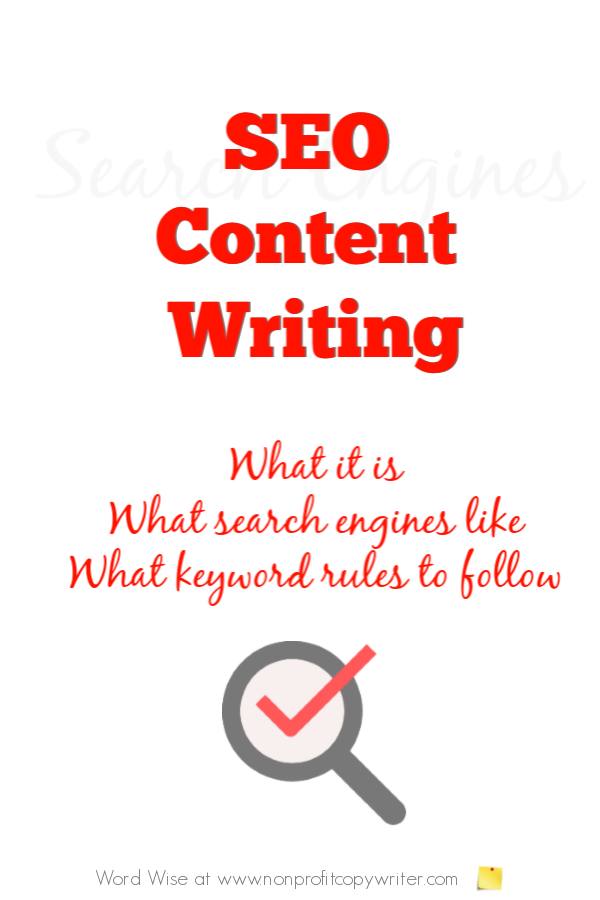Save Time: Get 5 Simple Writing Tips
you can put to use in 10 minutes
What Is SEO Content Writing? Tips for Strong Search Results
Award-winning writer Kathy Widenhouse has helped hundreds of nonprofits and writers produce successful content , with 750K+ views for her writing tutorials. She is the author of 9 books. See more of Kathy’s content here.
“What is SEO content writing?”
It’s a question I hear a lot – and not just from writing newcomers. The idea of creating content that conforms to any kind of acronym can be intimidating, akin to following a secret military code.
Your fears may be especially acute if you’re not technically-minded. Search engines are driven by a mass of algorithms, right? The complexities make even the most avid tech geek’s mind swim.
But there’s good news behind all those bytes, and it’s this: you can create online content that appeals to search engines without understanding all that technical gobbledygook.
You simply need to understand and apply a few key writing principles.
Let’s break it down.
What is the “SEO” in SEO Content Writing?
SEO is acronym for “search engine optimization.” (Here’s a glossary of more keyword jargon.)
- A search engine is a computer program that looks for words or terms across the web. The results of the search are returned in a list, also called search engine results pages (SERPs). AOL Search, Ask, Bing, Dogpile, Google, and Yahoo! are examples of popular search engines.
- Optimization is the act of making your web page as effective as possible when it comes to appearing on results pages.
Put together, SEO is the process of creating a page for the web to return strong search results.
When your page appears higher on the results – ideally on the first page or two– then more users see your link, click on your page, and land on your site.
You get more traffic.
So if you’re looking for more organic traffic (visitors to your site that land there for free, simply because they found you via search engine results) then you want to optimize your pages in a way that appeals to search engines.
In other words, you want to get a knack for SEO.
What is “Content Writing” in SEO Content Writing?
Content writing is relevant, valuable written information (versus visual information, like videos or infographics.)
Written content can span the gamut from blog posts to articles, newsletters, landing pages, presentations, social media, eBooks, pamphlets, brochures … you get the idea. If it’s written and if it offers relevant, valuable information, then it’s considered to be content writing.
So … What Is SEO Content Writing?
- SEO = the process of creating a page for the web to return strong search results
- Content writing = relevant, valuable written information
So what is SEO content writing? Put together …
SEO content writing is valuable, written, online information that returns strong search results.
Just how does your webpage land in the top of the search results? A few keyword rules are helpful to follow.
- Your page focuses on one or two keywords (terms or phrases associated with a particular topic)
- Your page tags the keyword phrase(s)
- Your page’s keyword phrase is positioned in six crucial places on the page
- Your page content contains quality, helpful, well-organized information
- Your page content is conversational
- Your page content doesn’t overstuff or overuse the keyword
Write SEO Content That Goes Beyond Search Results
In your hunger to climb to the top of SERPs, you may be tempted to focus solely on those keyword rules.
But once a user gets to your site, you want them to stay there, right? You want your readers to become fans. You want them to return to your site over and over.
While it’s important to drive readers to your site, that’s just one piece of the website success puzzle.
So follow the keyword rules, but don’t get hung up on them. Use them as one helpful tool in the web writing process.
And make sure you always deliver valuable content.
When you write useful, relevant content, then readers will return to your site again and again.
And that’s a whole point of having a website, isn’t it?
More Web Content Writing Tips
Web Content Writing: A Quick Tutorial ...
What Are Keywords in SEO, Anyway? A Simple Tutorial ...
Use 3 Types of Web Traffic to Build Your Blog or Website ...
The Best Word Count for SEO ...
How Keywords Work: an overview ...
Build Backlinks and Build Your Traffic: A Beginner’s Guide ...
How to Search for Keywords the Easy Way ...
Searching for Keywords? Use These SEO Writing Terms ...
The Skinny on Thin Content: Don’t Put Rankings Over Readers ...
Contextual Links and Why You Need Them on Your Website ...
The 3 Types of Links Your Website Needs and How to Build Them ...
6 places to use keywords in web pages and blog posts ...
Keyword Glossary: Quick SEO Jargon at Your Fingertips ...
Long Tail Keywords: A Quick Guide to Using Unpopular Search Terms ...
3 Ways to Help People Find Your Website and Build Traffic ...
Terms You Need to Know for Writing Website Content: A Glossary ...
More Online Writing Tips on our Pinterest board ...
Return from What Is SEO Content Writing? to Nonprofit Copywriter home
As an Amazon Associate I earn from qualifying purchases.
Share This Page

Named to 2022 Writer's Digest list
BEST GENRE/NICHE WRITING WEBSITE


Stop Wasting Time!

Grab your exclusive FREE guide, "5 Simple Writing Tips You Can Put to Use in 10 Minutes or Less"











